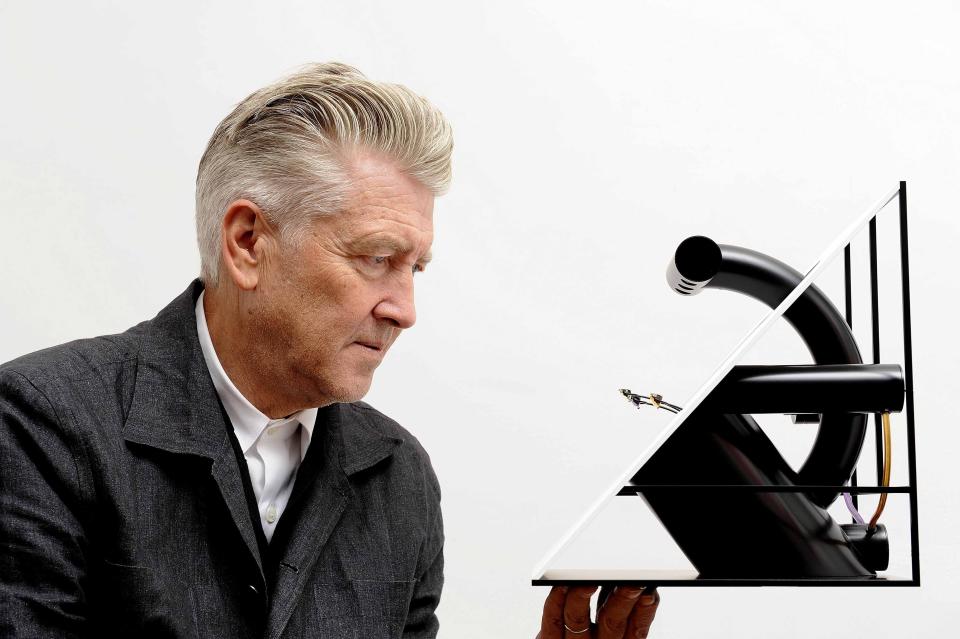David Lynch: "The idea was white light shouts out colors through stones"
Beginning April 3, David Lynch's artwork Jeweled Triangle, a lamp with citrine, amethyst and green beryl gemstones, will be on display in Paris as part of the exhibition Cartier, Jeweler of the Arts at the Fondation Cartier. Prior to the exhibition, the artist and director spoke with Relaxnews about the ingredients for a good patron/artist relationship and shared insight about his artwork and the city of Paris.
Relaxnews: After a fifty-year artistic career, you've become a Renaissance man, dedicating yourself to art in all its forms. Your current patron seems to be Cartier. How did that come about?
David Lynch: I forget what year [2007, ed.] but Cartier gave me a big show, a retrospective. It was called The Air is On Fire, based on a small drawing I did. That started this love affair with Cartier.
RN: In your opinion, what are the ingredients for a good patron/artist relationship?
DL: In the old days, there were patrons. There still are. I think it’s very beautiful when someone supports the artists and supports them in a certain way, by giving freedom and encouragement. This kind of relationship always works very beautifully and things come out of this that wouldn’t come out otherwise.
RN: What was your reaction when Cartier asked you to work with discarded stones?
DL: I thought, it's one of those things: an opportunity. It comes along -- like I said it wouldn't come along otherwise -- and you start focusing on this, you could say, problem, and when you focus on the thing, solutions come; ideas come and out comes something. It's a kind of a beautiful thing. This lamp wouldn't exist if it wasn't for this thing where they have gems and they say make something from it.
RN: How did you get the idea of making a lamp with these stones?
DL: I don't know when it happened but I liked the idea of light passing through the stones, creating a color. The idea was white light makes colors in a crystal. You know when the rainbow comes out, it's so magical. So the idea was white light shouts out primary colors. There are no stones really that have absolute red, yellow and blue. But these stones are almost like secondary colors.
RN: Why did you choose to make a utilitarian object, specifically a lamp?
DL: I like lamps. I like the idea of creating a mood in a room and light goes a long way to creating a mood. So when they [Cartier] start thinking about stones and light, I think a lamp. I like the idea that there could be a room and you turn this lamp on -- which is on a dimmer, so you can make it very bright or dim -- and it could create a beautiful mood in the room. That mood -- I don't know exactly what it will be, what it will cause people to do, but hopefully they'll live a beautiful experience with that light.
RN: After Philadelphia and Los Angeles, Paris seems to have become your artistic base. How does the city inspire you?
DL: Personally, Los Angeles for me is the best, because of the light and the feeling of freedom. But Paris is second, a very close second [smile], because of a great feeling in this place. It's a way that the French think and live. It's very, very special. I've always said that. That love of the arts, all the arts; everything is an art form for the French. It starts when they're little. In this museum, I see little school kids coming in and going around and they love taking everything in. In America, it probably happens, maybe because they're copying the French, but it doesn't happen as much. Kids aren't exposed to the things they are here. They don't grow up learning about a great chef's work, with food and preparation and all these things. And they probably don't get a glass of vin rouge at dinner [laugh]. This French way is so good. Great support of all the artists, more than any other country I think. It's pretty thrilling.
RN: Your last feature film, Inland Empire, was released six years ago. Not to say that you lost interest in film, but did you lose interest in cinema, as an industry?
DL: No. As everybody knows cinema went through a huge change: from celluloid to digital. And now that change is pretty much complete. Many things have still to happen as a result of this change, but now the digital cameras are surpassing at least the 35mm camera in quality. And now there are so many tools to manipulate that image in postproduction. It's so beautiful what's going on. I love the cinema. I just haven't gotten an idea that I fell in love with but maybe this will happen.
Cartier, Jeweler of the Arts runs April 3-21. Reservation with the Visitor's Department is necessary. For more information visit www.fondation.cartier.com/cartier.



